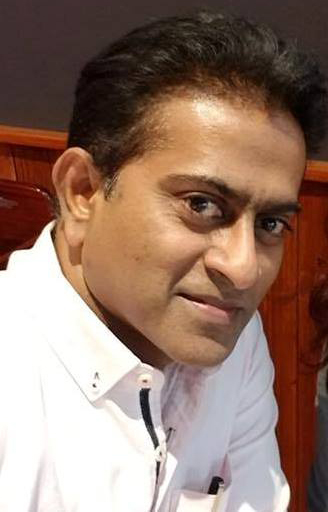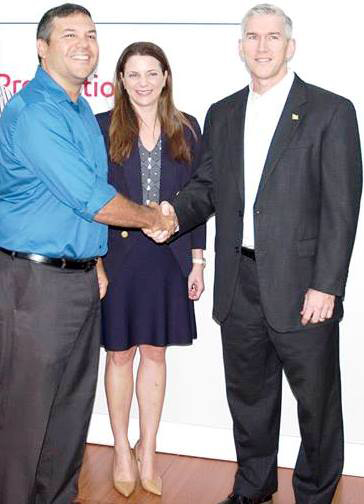Shipping company, John Fernandes Limited (JFL) is stepping up preparations for a multi-million US$, shore-based support contract with Saipem, a key contractor for ExxonMobil.
The Milan, Italy-based Saipem will be doing work on ExxonMobil’s Liza 1 project from which oil is expected to begin flowing in 2020.
The contract begins in October of this year when the first set of pipes will land at the Wieting and Richter Water Street, Georgetown facility and is set to last for 11 months and is subject to extension.
JFL’s CEO, Philip Fernandes explained that Saipem, one of ExxonMobil’s tier one contractors – had been contracted to supply and install the risers and umbilicals connecting the subsea operations with the Floating Production Storage and Offloading platform.
ExxonMobil had last year awarded a contract to Saipem for the engineering, procurement, construction and installation (EPCI) of the subsea umbilicals, risers and flow lines for the Liza deep water project.
Saipem, in turn, subcontracted, the shore-based aspects of the job to JFL and JFL is set to commence work in October this year as Saipem prepares for its offshore works.
Fernandes explained a part of JFL’s scope of works under the agreement. “They have now contracted us to provide shore-based services. When you’re conducting operations in the middle of the ocean you need a shore base where you bring everything. So the pipes will come here and things that they need will come here to JFL. We will keep it, and of course facilitating what needs to be done such as maybe washing pipes or cleaning before being loaded on to these supply vessels. So we bring it in large containers, offload and then smaller vessels take it out to the ocean where it needs to be. In addition to pipes, there are all sorts of things that will be needed to go in and come back out, say for example, equipment parts and things like that.
“We have rented the property of Wieting and Richter and developed it into a shore base. We had to do extensive work on it. We filled in some swampy areas, had to dismantle their old wooden decking and produce a new concrete pier that meets the requirement of this kind of business. So we are offering that facility as an oil and gas facility and it is the only exclusive oil and gas base. (Not mixed with containers.) Saipem is going to be about 11 months and we hope of course to have other companies coming in. While Saipem is there they may take up the whole facility. The contract is such that they pay for what they use but their projections are that they may want the whole facility. We intend to have it just for oil and gas companies, we don’t intend (to use it) for containers.”
But Fernandes pointed out that while his company is ecstatic that it has been brought in as a part of Saipem, and by extension, Exxon’s local content commitments to this country, there have been challenges where although he has qualified and exuberant employees ready to work, they have to await foreign certification.
“One of the challenges is that people and equipment have to be certified to be used in this industry (and) there is no local certification body for this. So it means we have to privately hire Trinidadian or other firms who are recognized to come in and certify our people and equipment,” Fernandes pointed out.
Asked about what role he thinks could be taken by government to equip its citizenry with the necessary wherewithal to cater for the sector, he said, “I would think it could happen on a national level… where one of these technical institutions like GTI (Government Technical Institute) or other educational institutions can train them and certify them . That is certainly one way you can do it.”
Fernandes referred this newspaper to Saipem’s Country Manager Thuran Nadarajah to explain more about what his company expects and how it would be working along with JFL to attain its objectives.
‘Footprint’

During that interview, Saipem’s CEO pointed out that his company is working to leave a footprint of its own here.
“The whole idea of Saipem is to leave behind a footprint, a sustainability programme which develops into a footprint. We have never gone out showcasing ‘Hey we do this or that’. What we do is we work from the background, we are focused on local content, on developing the local ability to bring out the expertise and also see the skills and match them. The moment you give them that foundation and procedural requirements it is easier to bring them up to speed in what is required in the oil and gas sector, especially on safety, especially on work ethics and attitude wise. These are things we look at and we want blend them inside and to develop a regional player then international,” Nadarajah said.
“As you already know, oil is the talk of the town and hopefully will be here for some decades but as you know this is a virgin oil and gas country and there is no manual for how to do things. So we are building the manual. Whatever the assumptions made prior, we are proving some cases are wrong, noting some cases are right and so we are looking to see. We never assumed this is right or that is wrong since we are working here to find the best solution…it will take until the conclusion of a successful phase one then before we can say we will have the right model to say ‘this one works’ then that will be the basis of all our future projects.”
Being not a person to lead from a boardroom, Nadarajah takes a hands on approach in the executing of his duties and can be found every day at the W&R jobsite overlooking works and interacting with employees.
While locals have taken a while to adapt to the rigid safety requirements and procedures set out by Saipem, Nadarajah says that they are also adapting and he is confident that they will be the leaders of safety standards here.
In June of last year, Guyana Shore Base Inc (GYSBI), a consortium comprising Muneshwers Limited, TOTALTEC Oilfield Services, Pacific Rim Constructors and LED Offshore had won against JFL to provide shore-based services directly to ExxonMobil.
The company had been developing the waterfront port facility at Houston, East Bank Demerara since 2016 and invested over US$10 million to capitalise on Guyana’s developing oil and gas industry.
Country Manager Robin Muneshwer had explained what the services would entail. “Essentially, what we want to be is a one-stop shop for the supply vessel. When the vessel comes from the rig and it comes here, it must be able to satisfy all its needs, get its pipes, its fuel, its oil, its water, the powder plant, the mud plant. You know? They come here, they get everything done and they go back,” he said.





